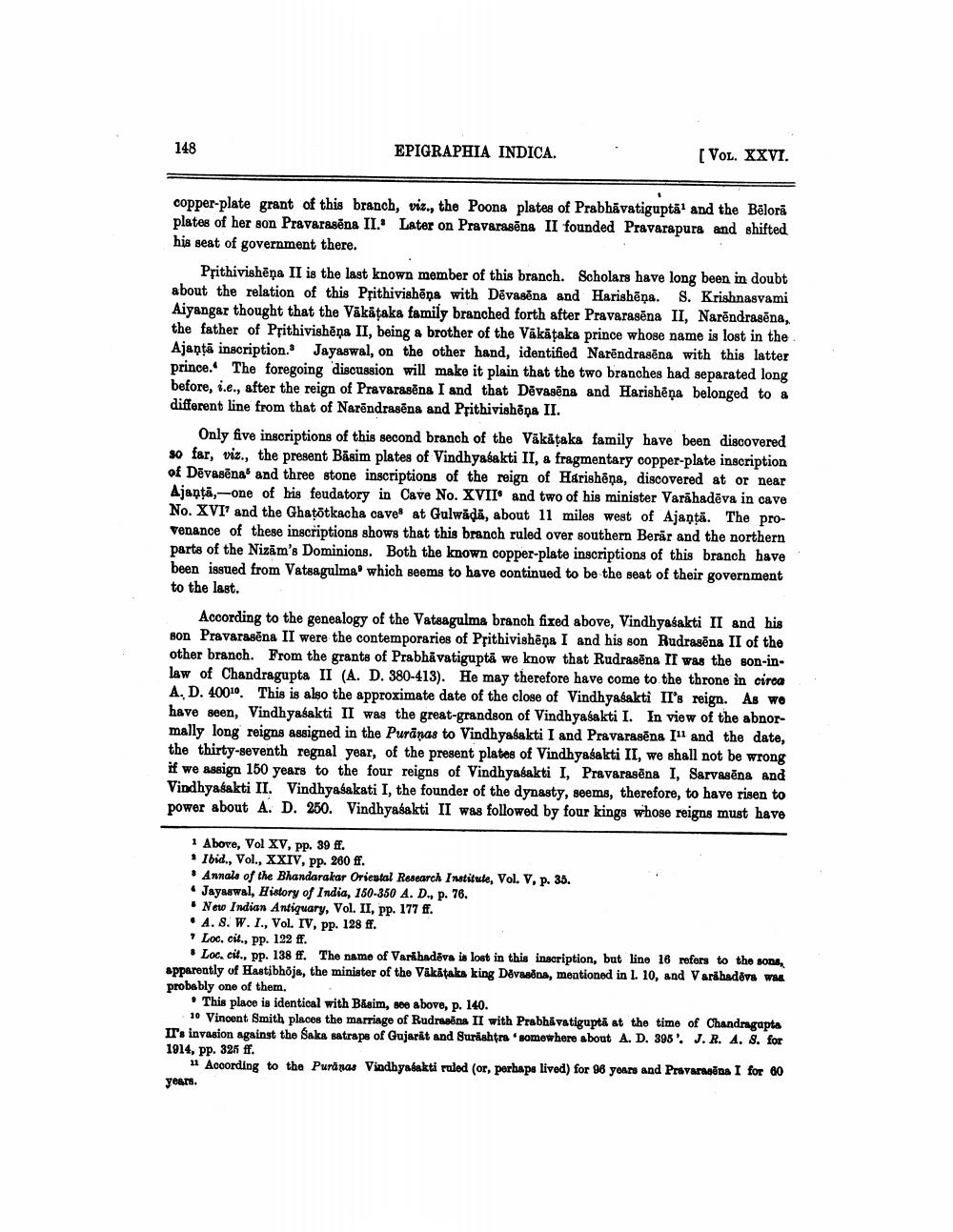________________
148
EPIGRAPHIA INDICA.
[VOL. XXVI.
copper-plate grant of this branch, viz., the Poona plates of Prabhavatigupta1 and the Bēlora plates of her son Pravarasena II. Later on Pravarasēna II founded Pravarapura and shifted his seat of government there.
Prithivishēņa II is the last known member of this branch. Scholars have long been in doubt about the relation of this Prithivishēņa with Devasena and Harishēņa. S. Krishnasvami Aiyangar thought that the Väkäṭaka family branched forth after Pravarasēna II, Narendrasēna, the father of Prithivishēņa II, being a brother of the Vākāṭaka prince whose name is lost in the Ajanta inscription. Jayaswal, on the other hand, identified Narendrasena with this latter prince. The foregoing discussion will make it plain that the two branches had separated long before, i.e., after the reign of Pravarasēna I and that Devasena and Harishēņa belonged to a different line from that of Narendrasena and Prithivishēņa II.
Only five inscriptions of this second branch of the Väkäṭaka family have been discovered so far, viz., the present Basim plates of Vindhyasakti II, a fragmentary copper-plate inscription of Devasena and three stone inscriptions of the reign of Harishēna, discovered at or near Ajanța, one of his feudatory in Cave No. XVII and two of his minister Varahadeva in cave No. XVI and the Ghatotkacha caves at Gulwada, about 11 miles west of Ajanța. The provenance of these inscriptions shows that this branch ruled over southern Berar and the northern parts of the Nizam's Dominions. Both the known copper-plate inscriptions of this branch have been issued from Vatsagulma which seems to have continued to be the seat of their government to the last.
According to the genealogy of the Vatsagulma branch fixed above, Vindhyasakti II and his son Pravarasēna II were the contemporaries of Prithivishēņa I and his son Rudrasena II of the other branch. From the grants of Prabhavatigupta we know that Rudrasena II was the son-inlaw of Chandragupta II (A. D. 380-413). He may therefore have come to the throne in circa A. D. 40010. This is also the approximate date of the close of Vindhyasakti II's reign. As we have seen, Vindhyasakti II was the great-grandson of Vindhyasakti I. In view of the abnormally long reigns assigned in the Puranas to Vindhyasakti I and Pravarasena Il and the date, the thirty-seventh regnal year, of the present plates of Vindhyasakti II, we shall not be wrong if we assign 150 years to the four reigns of Vindhyasakti I, Pravarasēna I, Sarvasena and Vindhyasakti II. Vindhyasakati I, the founder of the dynasty, seems, therefore, to have risen to power about A. D. 250. Vindhyasakti II was followed by four kings whose reigns must have
1 Above, Vol XV, pp. 39 ff.
Ibid., Vol., XXIV, pp. 260 ff.
Annals of the Bhandarakar Oriental Research Institute, Vol. V, p. 35.
Jayaswal, History of India, 150-350 A. D., p. 76.
New Indian Antiquary, Vol. II, pp. 177 ff.
A. 8. W. I., Vol. IV, pp. 128 ff.
Loc. cit., pp. 122 ff.
Loc. cit., pp. 138 ff. The name of Varahadeva is lost in this inscription, but line 16 refers to the sons, apparently of Hastibhöja, the minister of the Väkataka king Devasõna, mentioned in 1. 10, and Varahadeva was probably one of them.
This place is identical with Basim, see above, p. 140.
10 Vincent Smith places the marriage of Rudrasena II with Prabhavatigupta at the time of Chandragupta It's invasion against the Saka satraps of Gujarat and Surashtra somewhere about A. D. 395'. J. R. A. S. for 1914, pp. 325 ff.
11 According to the Puranas Vindhyaéakti ruled (or, perhaps lived) for 96 years and Pravarasēna I for 60
years.




